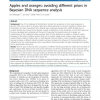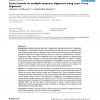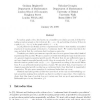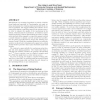886 search results - page 46 / 178 » On the Autoreducibility of Random Sequences |
BMCBI
2010
13 years 7 months ago
2010
Background: One of the challenges of bioinformatics remains the recognition of short signal sequences in genomic DNA such as donor or acceptor splice sites, splicing enhancers or ...
BMCBI
2007
13 years 7 months ago
2007
Background: Multiple sequence alignment is fundamental. Exponential growth in computation time appears to be inevitable when an optimal alignment is required for many sequences. E...
PAMI
2007
13 years 7 months ago
2007
This paper exploits the properties of the commute time between nodes of a graph for the purposes of clustering and embedding, and explores its applications to image segmentation a...
RSA
2010
13 years 6 months ago
2010
A random graph order, also known as a transitive percolation process, is defined by taking a random graph on the vertex set {0, . . . , n − 1}, and putting i below j if there i...
SOUPS
2009
ACM
14 years 2 months ago
2009
ACM
Randomness is a necessary ingredient in various computational tasks and especially in Cryptography, yet many existing mechanisms for obtaining randomness suffer from numerous pro...




